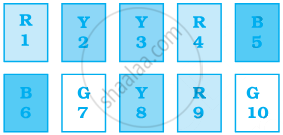Advertisements
Advertisements
Question
Cards numbered from 11 to 60 are kept in a box. If a card is drawn at random from the box, find the probability that the number on the drawn card isa prime number less than 20
Solution
The cards are numbered from 11 to 60.
∴ Total number of outcomes = 60 − 10 = 50
Prime numbers less than 20 from 11 to 60 are 11, 13, 17 and 19.
So, the favourable number of outcomes are 4.
∴ P(number on the drawn card is a prime number less than 20) =\[\frac{\text{ Favourable number of outcomes }}{\text{ Total number of outcomes }} = \frac{4}{50} = \frac{2}{25}\]
APPEARS IN
RELATED QUESTIONS
In a school, students decided to plant trees in and around the school to reduce air pollution. It was decided that the number of trees, that each section of each class will plant, will be double of the class in which they are studying. If there are 1to 12 classes in the school and each class has two sections, find how many trees were
planted by the students. Which value is shown in this question?
Two different dice are rolled together. Find the probability of getting the sum of numbers on two dice to be 5.
Three distinct coins are tossed together. Find the probability of getting
(i) at least 2 heads
(ii) at most 2 heads
In the accompanying diagram a fair spinner is placed at the center O of the circle.
Diameter AOB and radius OC divide the circle into three regions labelled X, Y and Z. If
∠BOC = 45°. What is the probability that the spinner will land in the region X?(See fig)

Cards numbered from 11 to 60 are kept in a box. If a card is drawn at random from the box, find the probability that the number on the drawn card is a prime number less than 20.
Two different coins are tossed simultaneously. The probability of getting at least one head is
(A)`1/2`
(B)`1/8`
(C)`3/4`
(D)`7/8`
Cards numbered from 11 to 60 are kept in a box. If a card is drawn at random from the box, find the probability that the number on the drawn card is an odd number
Two coins are tossed simultaneously. What is the probability of getting at least one head?
A number is selected from numbers 1 to 25. The probability that it is prime is
A bag contains 4 white balls, 5 red balls, 2 black balls and 4 green balls. A ball is drawn at random from the bag. Find the probability that it is not green.
Two different dice are tossed together. Find the probability that the number on each die is even.
A bag contains 3 white, 5 black and 2 red balls, all of the same shape and size. A ball is drawn from the bag without looking into it, find the probability that the ball drawn is a black ball.
Three identical coins are tossed together. What is the probability of obtaining:
no head?
A book contains 92 pages. A page is chosen at random. What is the probability that the sum of the digits in the page number is 9?
A coin is tossed once. Find the probability of not getting a head
You are walking along a street. If you just choose a stranger crossing you, what is the probability that his next birthday will fall on a Sunday?
Frame two problems in calculating probability, based on the spinner shown here.
The probability of getting number 6 in a throw of a dice is `1/6`. Similarly the probability of getting a number 5 is `1/5`.
The probability of getting a prime number is the same as that of a composite number in a throw of a dice.
Sonia picks up a card from the given cards.

Calculate the probability of getting B card bearing number > 7
